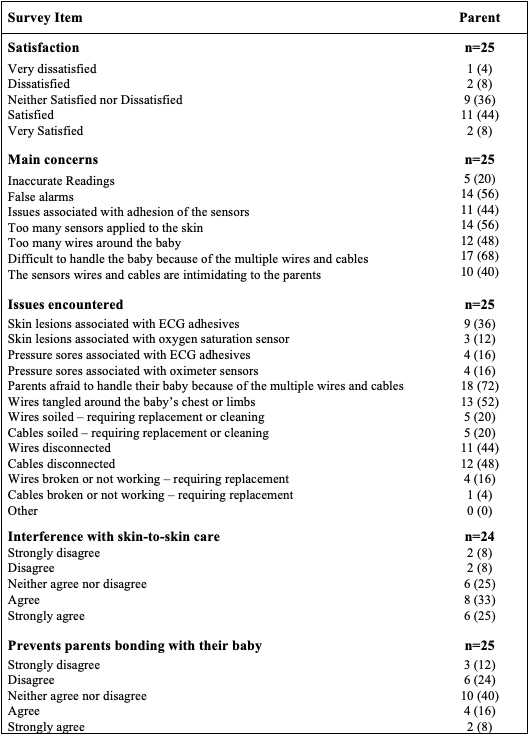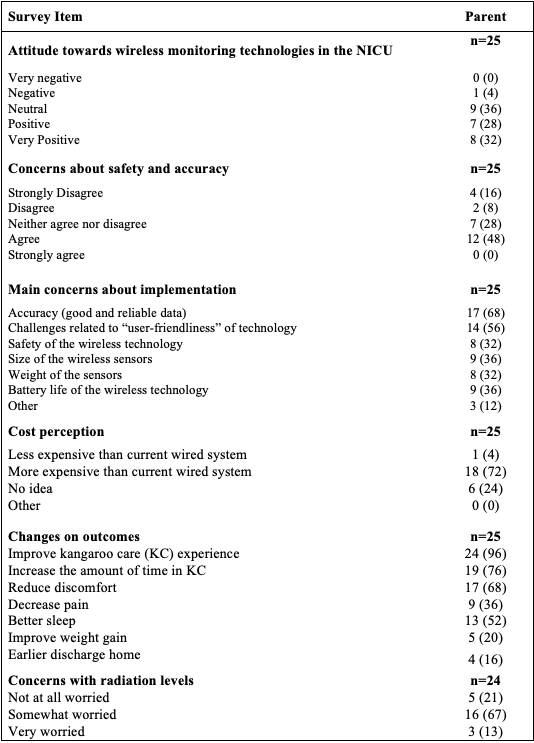Neonatology
Session: Neonatal General 6: POCUS, Technology in NICU
157 - Advanced Wireless Wearable Skin Sensors in the NICU: Parents Perspective
Sunday, May 5, 2024
3:30 PM - 6:00 PM ET
Poster Number: 157
Publication Number: 157.2046
Publication Number: 157.2046

Eva B. Senechal, BA&Sc.
PhD. Candidate
McGill University
Montréal, Quebec, Canada
Presenting Author(s)
Background: The Neonatal Intensive Care Unit (NICU) cares for ill and unstable neonates, using continuous vital sign monitoring. Currently, this monitoring relies on skin sensors connected to monitors by using wires/cables, which can lead to issues related to tangling, discomfort, and interference with nursing work and Kangaroo Mother Care (KMC). Advances in wireless skin sensors have sparked efforts to develop a wireless NICU.
Objective: To understand parents’ perspectives on the current NICU wired monitoring system and a potential wireless wearable system.
Design/Methods: A survey was developed with input from NICU HCP’s. The survey encompassed 17 questions related to the use of the current wired monitoring system and their opinions towards the development and implementation of a wireless NICU monitoring system (multiple-choice, Likert scales, and short answers). The survey was disseminated exclusively to parents of infants admitted to the Montreal Children's NICU for a minimum of five days. A descriptive analysis was applied.
Results: Responses from 25 parents from 24 infants were obtained. The median length of infant stay at the time of parent’s completion of the survey was 21 days (IQR= 8 to 28). Thirteen parents (52%) were satisfied with the current monitoring system. Most frequent concerns were the number of adhesives applied to the skin (56%), false alarms (56%), and difficulties handling their baby due to multiple wires and cables (68%). Common issues were fear of handling their baby due to the equipment (72%) and tangling of the wires around the body (52%) (Table 1). Furthermore, 14 parents (58%) reported feeling that the current system interfered with their ability to practice KMC. Parents generally felt positively about the possibility of using wireless technology in the NICU (60%) as they believe it would improve KMC experience (96%) and duration (76%), reduce discomfort (68%), and improve sleep (52). However, most of them were concerned about possible radiation exposure (76%), accuracy (68%), “user-friendliness” (56%), and costs (72%) related to the new technology (Table 2).
Conclusion(s): Parental satisfaction with the current wired monitoring system in the NICU is relatively low, with several concerns, particularly related to equipment as a barrier to infant handling and KMC. There is a favorable attitude towards the adoption of wireless technology, conditional to its cost-effectiveness, feasibility, safety, and accuracy.


